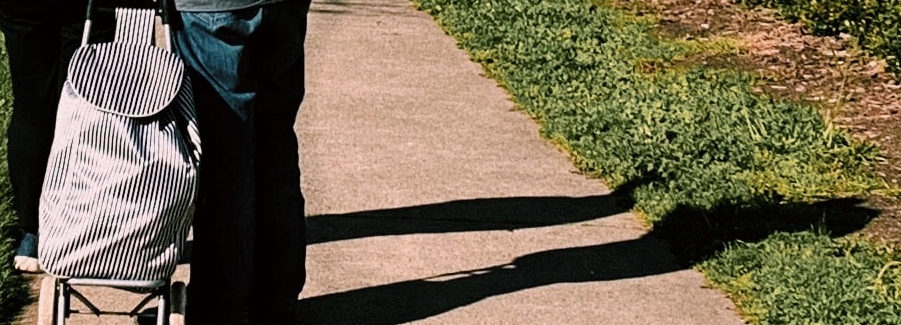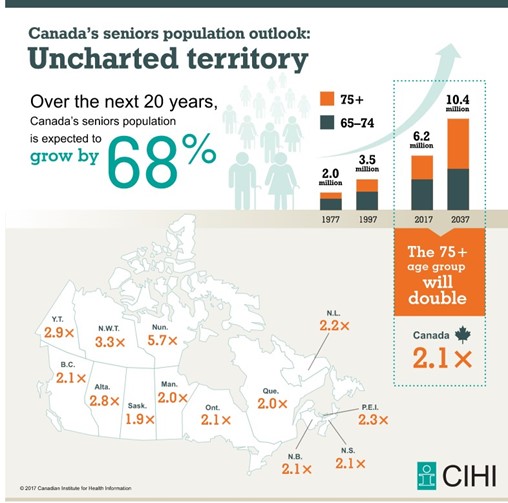Fighting Ageism and Ageist mindset: Taking a public health approach

Mary Ndu, Ph.D. Candidate, Health and Rehabilitation Sciences
Hirra Chohan, BHSc, Health Sciences, Honours Specialization in Biology
June 13, 2022
“You do not look your age,” “You look so good for 70,” “She has an amazing dress sense for her age,” “You do not look a day over 40!” and “Uhm Hmm, she is so cute for an old person.” These comments are constantly used to describe an older person. Amusing? Many of those older people were fashion icons and industry experts in their youth.
Ageing is an interaction of multiple factors that promote health and wellness, the lack of which would affect the ageing process and life expectancy. In the past few decades, Canada has experienced a demographic transition that has slowly seen an increase in its population aged 65 years and older (CIHI, 2022). The change in demography is likely attributable to decreased mortality rates resulting from available quality health care and improved quality of life. The current statistics on Canada’s aged population indicate a higher percentage of those aged 65 and above (CIHI, 2022). Yet, an ageist mindset persists. One may even opine that ageism has joined the list of shadow pandemics.
Ageism refers to stereotypical views, prejudices, and discriminatory acts against others or oneself based on age (World Health Organization, 2021). Globally, people are ageing, and we see more and more societies with people living longer. According to the World Health Organization (WHO) report on ageing, people live 20 years more than they did 50 years ago. The WHO estimates that 2.1 billion people will be aged 60 and above by 2050. Butler (1969) described ageism as the systemic discrimination and stereotyping based on a person’s age. It reflects a deep-seated personal uneasiness and revulsion for aging, translating into society’s view on ageism. Unfortunately, this revulsion permeates every fabric of society. As Butler (1969) opines, it comes from attaching ageing to the presence of disease, disability, powerlessness, uselessness, and death. If we believe Butler’s assertion, developed with reference to dominant discourses within post-World War II Global North, this would explain our society’s persistent war on ageing because of the perception that it is vile.
While we will focus on ageism affecting older people, we would like to note that ageism is not specific to any age. It can affect people of all ages. The Global Report on Ageism reports that in Europe, “younger people report more perceived age discrimination than other age groups.” (World Health Organization, 2021, p. 88). According to the WHO, as early as four years old, one is already aware of existing stereotypes on ageing, which form our world views and perception of people of different ages. We see ageism in how adolescents or young adults are treated like they are incapable of making decisions that affect their lives or the condescending and patronizing interactions with the elderly when we call them “cute,” “experienced,” or “knowledgeable for someone old.” We also see it when women of a certain age are stereotyped for being single or without children. It is, therefore, necessary to recognize the intersectionality of ageism with other social issues such as race, sex, and gender. Current statistics indicate the need to take an intersectional lens to age. For instance, evidence indicates that older adults may be more vulnerable to ageism-related abuse and discrimination based on intersecting devaluaed social identities, with greater impact on women with the lower social and economic status, racialized, and sexual minorities (Canada, 2022).
What does the data say?
Globally, one in two persons identifies as ageist against older people (WHO, 2021). In Canada, one in three persons identifies as ageist against older people (Revera, 2014). Although, sometimes, it can be conscious and intentional, ageism often emerges through an unconscious bias where people are often unaware they are being ageist. If, like many other social issues and isms, a large percentage of society shares the same attitude and perceptions about a particular issue concerning a segment of the population, these beliefs will find a way to embed themselves into social structures.
The WHO decries the lack of robust data on ageism globally; however, what we know of Canada’s ageing data reveals a worrying trend in older people’s experiences within society. A 2014 Report on Ageism in Canada found that Canadians negatively perceive ageing. While older adults are optimistic about ageing, the younger generations are not (Revera, 2014). Ageism takes many forms; internalized ageism: feeling and worrying about ageing, including treating older people with disrespect and disdain; institutional ageism: excluding the aged in health research, mandatory retirement ages, perception of unworthiness in health care service delivery, and social isolation with people avoiding to interact with older people. Every year, many older people experience one form of abuse. For instance, about ten percent of the elderly are victims of crime, especially property crime annually, with about one percent of seniors experiencing violent crime (Statistics Canada, 2019, 2021). Yet, many of these abuses are never reported to the police. Of the number of reported abuse cases to police, eleven percent happened in institutional care, and two-thirds of the cases were older women (Statistics Canada, 2021). In Ontario, for instance, elder abuse is not reported because of the attached social stigma and fear of losing caregiver support, especially if it is abuse by a family member (OHRC, 2022). According to Statistics Canada (2021), while older people are prone to other forms of abuse, such as financial crimes, family and caregiver abuse is the most prevalent form of abuse, occurring in institutional housing and homes.

Source: Canadian Insitute for Health Information
Currently, there is no specific criminal code or statute that criminalizes ageism. However, they are implied in existing federal and provincial laws. According to the Canada Justice website, “Newfoundland and Labrador’s Neglected Adults Welfare Act—the only neglect specific statute in Canada...” Although, every province has an implied provision in its laws. For instance, under the Retirement Homes Act 2010, reporting elder abuse in Ontario is mandatory. If you want to know more about the legislation, please visit http://ccelderlaw.ca/.
Our position
We do not believe that criminalizing ageism will address the issue. We believe that, like many other social issues, ageism requires a social reconditioning approach to address. Over 50 years ago, Butler (1969) argued that ageism would parallel racism as a significant issue in the future—which is happening now. While other forms of -isms focus on a segment of the population, ageism takes a life course approach across all people regardless of race or sex. We recognize that the first step towards addressing the issue of ageing is admitting our biases and prejudices. In 2014, when Japan saw a rise in its aged population, Japan took this approach and has successfully reoriented its national consciousness about ageing. There is a lesson to learn from their approach where the elderly are now treated as vital stakeholders in the community. Perception of the ageing body is no longer one of fear or pity but something to look forward to in the future. It is proof that changing or improving people’s understanding of ageism is a step toward changing the discourse.
In writing this blog, we became aware of our biases and how we have implicitly been ageist in our approach to older people. For this reason, we took a self-reflective journey on our experiences, perceptions and opinions on ageing. Unfortunately, our attitudes and opinion do not come from hatred or fear but rather from a place of pity. However, why do we have to pity older people when we see them shopping or just taking a walk? Why do we assume they do not have the intelligence or knowledge about technology, fashion or current affairs? Why are they cute when we see them dressed nicely? Or dancing? Why is the default pity when we see older people? Is it possible to project our self-pity on them, knowing we will get old someday too? How did society get to this point? At what point did age, something so mundane, become society’s focus? These were just some questions we had to answer to get to the truth about our own biases and prejudices. We want to invite everyone who reads this to take this journey. We believe that to curb ageist mindsets truly, it is first essential to admit where and how we got to this point. We need to begin shifting our collective perception of old age. As a society, we must make a paradigm shift, not slowly but swiftly, given the rising rate of elder discrimination and abuse.
References
Butler, R. N., (1969). Ageism: Another Form of Bigotry, The Gerontologist, Volume 9( 4): 243–
246, https://doi.org/10.1093/geront/9.4_Part_1.243
Canada (2022) Crime and abuse against seniors.
https://www.justice.gc.ca/eng/rp-pr/cj-jp/fv-vf/crim/sum-som.html
CIHI (2022) https://www.cihi.ca/en/infographic-canadas-seniors-population-outlook-uncharted- territory
Revera (2014) Revera Report on Ageing. The International Federation of Ageing and Reveral Inc.
Statistics Canada (2021). Section 4: Police-reported family violence against seniors in Canada. https://www150.statcan.gc.ca/n1/pub/85-002-x/2021001/article/00001/04-eng.htm
World Health Organization. (2021). Global report on ageism. In Global Report on Psoriasis (Vol. 978). http://www.who.int/about/licensing/copyright_form/index.html%0Ahttp://www.who.int/about/licensing/
Photo by Lennon Cheng on Unsplash
